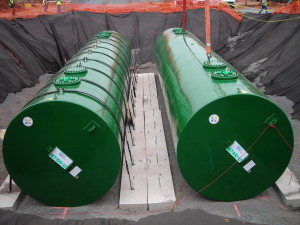EPA has issued significant revisions to the existing 1988 underground storage tank regulation that will impact most, if not all, businesses with USTs.
EPA regulates over 571,000 USTs, down from a high of 2.1 million USTs in 1984.
As of January 1, 2015, more than 525,000 UST releases (e.g., leaks) had been reported since 1988, many contaminating soil and drinking water.

Photo U.S. EPA
An UST is one or more tanks and any underground piping connected to the tanks that have at least 10% of their combined volume underground. The federal UST regulation applies to USTs storing petroleum and certain hazardous substances (i.e., less than 10,000 tanks have hazardous contents).
Some tanks are excluded from federal regulation including tanks storing heating oil used on the premises where it is stored, tanks on or above the floor of underground areas, such as basements or tunnels, etc.
Note, many states have a state program approval from EPA. In these states, the state’s UST regulation is followed in lieu of the federal regulation and states have 3 years to come into compliance with this new federal edict. Click for a list of states with state program approval.
This 2015 regulation changes certain portions of the 1988 UST technical regulation published in 40 CFR part 280. Nearly all businesses with USTs will be impacted by these new regulations and will in many instances have 3 years to come into compliance with the changes that include:
- Adding secondary containment requirements for new and replaced tanks and piping
- Adding operator training requirements
- Adding periodic operation and maintenance requirements for UST systems
- Adding requirements to ensure UST system compatibility before storing certain biofuel blends, and
- Removing past deferrals for emergency generator tanks, airport hydrant systems, and field-constructed tanks.
Although not a change, comments to the draft regulation noted that many UST owners apparently do not maintain the $500,000 per occurrence insurance coverage required of UST owners that handle less than 10,000 gallons per month.
Click here for an EPA issued comparison of the 1988 UST versus new 2015 UST regulations.
While the number of releases has gone down significantly since 1988, releases of petroleum from USTs into the environment are still a significant concern today. USTs are a crucial part of our country’s energy infrastructure. A properly installed and managed UST should not threaten the environment. These updated regulations are a move in that direction that will require capital investment and changes in operations, but should not overburden business; and, we would expect the same of the 38 states that will overhaul state delegated programs in the coming years.
